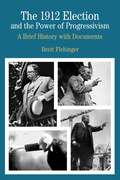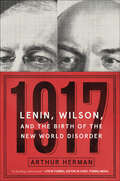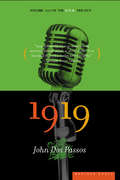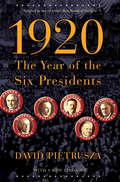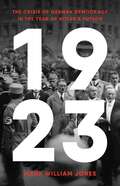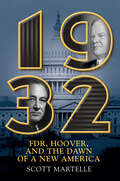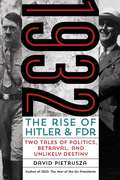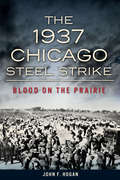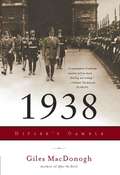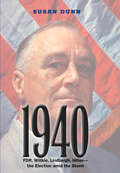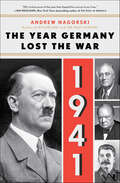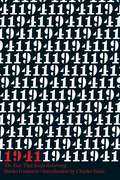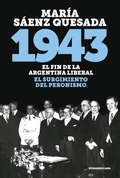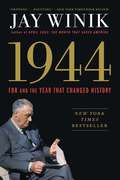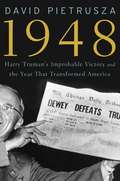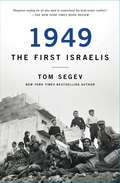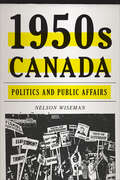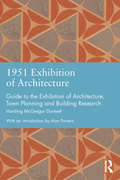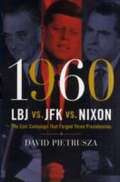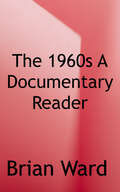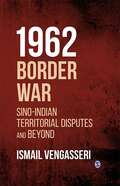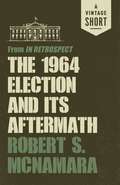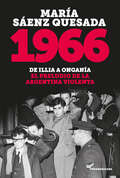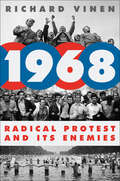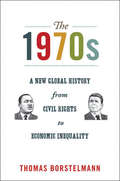- Table View
- List View
The 1912 Election and the Power of Progressivism: A Brief History With Documents
by Brett FlehingerFaced with the challenge of adapting America’s political and social order to the rise of corporate capitalism, in 1912 four presidential candidates — Theodore Roosevelt, William Howard Taft, Woodrow Wilson, and Eugene Debs — shaped Americans’ thoughts about their public futures. Their positions would come to frame national conversation over the role of corporations in American life, determine the relation between the state and society that still controls our thinking about market regulation, and usher in a period of Progressive reform. Connecting the debates of 1912 to some of the most pressing issues of the Progressive Era, this volume presents selected sensational speeches, correspondence between these important figures and their allies and opponents, and 12 lively political cartoons. The documents are supported by an interpretive essay, a chronology, a bibliography, and a series of questions for student consideration, including ideas for a classroom debate.
1917: Lenin, Wilson, and the Birth of the New World Disorder
by Arthur HermanHow did two men move the world away from wars for land and treasure to wars over ideas and ideologies—a change that would go on to kill millions?In April 1917, Woodrow Wilson—champion of American democracy but also of segregation, advocate for free trade and a new world order based on freedom and justice—thrust the United States into the First World War in order to make the “world safe for democracy”—only to see his dreams for a liberal international system dissolve into chaos, bloodshed, and betrayal.That October, Vladimir Lenin—communist revolutionary and advocate for class war and “dictatorship of the proletariat”—would overthrow Russia’s earlier democratic revolution that had toppled the powerful czar, all in the name of liberating humanity—and instead would set up the most repressive totalitarian regime in history, the Soviet Union. In this incisive, fast-paced history, the New York Times bestselling author Arthur Herman brilliantly reveals how Lenin and Wilson rewrote the rules of modern geopolitics. Prior to and through the end of World War I, countries marched into war only to advance or protect their national interests. After World War I, countries began going to war over ideas. Together Lenin and Wilson unleashed the disruptive ideologies that would sweep the world, from nationalism and globalism to Communism and terrorism, and that continue to shape our world today.Our new world disorder is the legacy left by Wilson and Lenin, and their visions of the perfectibility of man. One hundred years later, we still sit on the powder keg they first set the detonator to, through war and revolution.
1919: The Complete Trilogy [the 42nd Parallel, 1919, And The Big Money] (U.S.A. Trilogy #2)
by John Dos Passos&“A Depression-era novel about American tumult has—perhaps unsurprisingly—aged quite well.&”—The New YorkerIn 1919, the second volume of his U.S.A. trilogy, John Dos Passos continues his &“vigorous and sweeping panorama of twentieth-century America&” (Forum).Employing a host of experimental devices that would inspire a whole new generation of writers to follow, Dos Passos captures the many textures, flavors, and background noises of the era with a cinematic touch and unparalleled nerve.1919 opens to find America and the world at war, and Dos Passos&’s characters, many of whom we met in the first volume, are thrown into the snarl. We follow the daughter of a Chicago minister, a wide-eyed Texas girl, a young poet, and a Jewish radical, and we get glimpses of Woodrow Wilson, Theodore Roosevelt, and the Unknown Soldier.Named one of the Modern Library&’s 100 best English-language novels of the twentieth century, &“U.S.A. is a masterpiece&” (Tim O&’Brien) and 1919 is an unforgettable chapter in the saga. &“It&’s the kind of book a reader never forgets.&”—Chicago Daily Tribune
1920: The Year of the Six Presidents
by David PietruszaThe presidential election of 1920 was among history’s most dramatic. Six once-and-future presidents-Wilson, Harding, Coolidge, Hoover, and Teddy and Franklin Roosevelt-jockeyed for the White House. With voters choosing between Wilson’s League of Nations and Harding’s front-porch isolationism, the 1920 election shaped modern America. Women won the vote. Republicans outspent Democrats by 4 to 1, as voters witnessed the first extensive newsreel coverage, modern campaign advertising, and results broadcast on radio. America had become an urban nation: Automobiles, mass production, chain stores, and easy credit transformed the economy. 1920 paints a vivid portrait of America, beset by the Red Scare, jailed dissidents, Prohibition, smoke-filled rooms, bomb-throwing terrorists, and the Klan, gingerly crossing modernity’s threshold.
1923: The Crisis of German Democracy in the Year of Hitler's Putsch
by Mark William JonesHow Germany&’s fledgling democracy nearly collapsed in 1923—and how pro-democracy forces fought back In 1923, the Weimar Republic faced a series of crises, including foreign occupation of its industrial heartland, rampant inflation, radical violence, and finally Hitler&’s infamous &“beer hall putsch.&” Fanning the flames of anti-government and anti-Semitic sentiment, the Nazis tried to violently seize power in Munich, only failing after they were abandoned by like-minded conservatives. In 1923, historian Mark William Jones draws on new research to offer a revealing portrait of German politics and society in this turbulent year. Tracing Hitler&’s early rise, Jones reveals how political pragmatism and unprecedented international cooperation with the West brought Germany out of its crisis year. Although Germany would succumb to tyranny a decade later, the story of the republic&’s survival in 1923 offers essential lessons to anyone concerned about the future of democracy today.
1932: FDR, Hoover, and the Dawn of a New America
by Scott MartelleA fascinating behind-the-scenes look at a year in American history that still resonates today, 1932: FDR, Hoover, and the Dawn of a New America tells the story of a battered nation fighting for its own future amid the depths of the Great Depression. At the start of 1932, the nation&’s worst economic crisis has left one-in-four workers without a job, countless families facing eviction, banks shutting down as desperate depositors withdraw their savings, and growing social and political unrest from urban centers to the traditionally conservative rural heart of the country. Amid this turmoil, a political decision looms that will determine the course of the nation. It is a choice between two men with very diferent visions of America: Incumbent Republican Herbert Hoover with his dogmatic embrace of small government and a largely unfettered free market, and New York&’s Democratic Governor Franklin Delano Roosevelt and his belief that the path out of the economic crisis requires government intervention in the economy and a national sense of shared purpose. Now veteran journalist Scott Martelle provides a gripping narrative retelling of that vitally significant year as social and political systems struggled under the weight of the devastating Dust Bowl, economic woes, rising political protests, and growing demand for the repeal of Prohibition. That November, voters overwhelmingly rejected decades of Republican rule and backed Roosevelt and his promise to redefine the role of the federal government while putting the needs of the people ahead of the wishes of the wealthy. Deftly told, this illuminating work spotlights parallel events from that pivotal year and brings to life figures who made headlines in their time but have been largly forgotten today. Ultimately, it is the story of a nation that, with the help of a leader determined to unite and inspire, took giant steps toward a new America.
1932: The Rise of Hitler and FDR--Two Tales of Politics, Betrayal, and Unlikely Destiny
by David PietruszaTwo Depression-battered nations confronted destiny in 1932, going to the polls in their own way to anoint new leaders, to rescue their people from starvation and hopelessness. America would elect a Congress and a president ebullient aristocrat Franklin Roosevelt or tarnished Wonder Boy Herbert Hoover. Decadent, divided Weimar Germany faced two rounds of bloody Reichstag elections and two presidential contests doddering reactionary Paul von Hindenburg against rising radical hate-monger Adolf Hitler. The outcome seemed foreordained unstoppable forces advancing upon crumbled, disoriented societies. A merciless Great Depression brought greater perhaps hopeful, perhaps deadly transformation: FDR s New Deal and Hitler s Third Reich. But neither outcome was inevitable. Readers enter the fray through David Pietrusza s page-turning account: Roosevelt s fellow Democrats may yet halt him at a deadlocked convention. 1928 s Democratic nominee, Al Smith, harbors a grudge against his one-time protege. Press baron William Randolph Hearst lays his own plans to block Roosevelt s ascent to the White House. FDR s politically-inspired juggling of a New York City scandal threatens his juggernaut. In Germany, the Nazis surge at the polls but twice fall short of Reichstag majorities. Hitler, tasting power after a lifetime of failure and obscurity, falls to Hindenburg for the presidency also twice within the year. Cabals and counter-cabals plot. Secrets of love and suicide haunt Hitler. Yet guile and ambition may yet still prevail. 1932 s breathtaking narrative covers two epic stories that possess haunting parallels to today s crisis-filled vortex. It is an all-too-human tale of scapegoats and panaceas, class warfare and racial politics, of a seemingly bottomless depression, of massive unemployment and hardship, of unprecedented public works/infrastructure programs, of business stimulus programs and damaging allegations of political cronyism, of waves of bank failures and of mortgages foreclosed, of Washington bonus marches and Berlin street fights, of once-solid financial empires collapsing seemingly overnight, of rapidly shifting social mores, and of mountains of irresponsible international debt threatening to crash not just mere nations but the entire global economy. It is the tale of spell-binding leaders versus bland businessmen and out-of-touch upper-class elites and of two nations inching to safety but lurching toward disaster. It is 1932 s nightmare with lessons for today. "
The 1937 Chicago Steel Strike: Blood on the Prairie
by John F. HoganThis in-depth history of the Memorial Day Massacre brings new clarity to the conflicting reports that left too many questions unanswered. A violent period of American labor history reached its bloody apex in 1937 when rattled Chicago police shot, clubbed, and gassed a group of men, women, and children attempting to picket Republic Steel&’s South Chicago plant. Ten died and over one hundred were wounded in what became known as the Memorial Day Massacre. A newsreel camera captured about eight minutes of the confrontation, yet local and congressional investigations amazingly reached opposite conclusions about what happened and why. Now Chicago historian John Hogan sifts through the conflicting reports of all those entangled in that fateful day, including union leaders, news reporters, and an undercover National Guard observer revealed after seventy-six years.
1938: Hitler's Gamble
by Giles MacdonoghIn this masterful narrative, acclaimed historian Giles MacDonogh chronicles Adolf Hitler's consolidation of power over the course of one year. Until 1938, Hitler could be dismissed as a ruthless but efficient dictator, a problem to Germany alone; after 1938 he was clearly a threat to the entire world. It was in 1938 that Third Reich came of age. The Führer brought Germany into line with Nazi ideology and revealed his plans to take back those parts of Europe lost to "Greater Germany" after the First World War. From the purging of the army in January through the Anschluss in March, from the Munich Conference in September to the ravages of Kristallnacht in November, MacDonogh offers a gripping account of the year Adolf Hitler came into his own and set the world inexorably on track to a cataclysmic war.
1940: FDR, Willkie, Lindbergh, Hitler--the election amid the storm
by Susan DunnIn 1940, against the explosive backdrop of the Nazi onslaught in Europe, two farsighted candidates for the U.S. presidency--Democrat Franklin D. Roosevelt, running for an unprecedented third term, and talented Republican businessman Wendell Willkie--found themselves on the defensive against American isolationists and their charismatic spokesman Charles Lindbergh, who called for surrender to Hitler's demands. In this dramatic account of that turbulent and consequential election, historian Susan Dunn brings to life the debates, the high-powered players, and the dawning awareness of the Nazi threat as the presidential candidates engaged in their own battle for supremacy. 1940 not only explores the contest between FDR and Willkie but also examines the key preparations for war that went forward, even in the midst of that divisive election season. The book tells an inspiring story of the triumph of American democracy in a world reeling from fascist barbarism, and it offers a compelling alternative scenario to today's hyperpartisan political arena, where common ground seems unattainable.
1941: The Year Germany Lost The War
by Andrew NagorskiBestselling historian Andrew Nagorski &“brings keen psychological insights into the world leaders involved&” (Booklist) during 1941, the critical year in World War II when Hitler&’s miscalculations and policy of terror propelled Churchill, FDR, and Stalin into a powerful new alliance that defeated Nazi Germany. In early 1941, Hitler&’s armies ruled most of Europe. Churchill&’s Britain was an isolated holdout against the Nazi tide, but German bombers were attacking its cities and German U-boats were attacking its ships. Stalin was observing the terms of the Nazi-Soviet Pact, and Roosevelt was vowing to keep the United States out of the war. Hitler was confident that his aim of total victory was within reach.But by the end of 1941, all that changed. Hitler had repeatedly gambled on escalation and lost: by invading the Soviet Union and committing a series of disastrous military blunders; by making mass murder and terror his weapons of choice, and by rushing to declare war on the United States after Japan&’s attack on Pearl Harbor. Britain emerged with two powerful new allies—Russia and the United States. By then, Germany was doomed to defeat.Nagorski illuminates the actions of the major characters of this pivotal year as never before. 1941: The Year Germany Lost the War is a stunning and &“entertaining&” (The Wall Street Journal) examination of unbridled megalomania versus determined leadership. It also reveals how 1941 set the Holocaust in motion, and presaged the postwar division of Europe, triggering the Cold War. 1941 was &“the year that shaped not only the conflict of the hour but the course of our lives—even now&” (New York Times bestselling author Jon Meacham).
1941: The Year That Keeps Returning
by Charles Simic Michael Gable Slavko GoldsteinA New York Review Books OriginalThe distinguished Croatian journalist and publisher Slavko Goldstein says, "Writing this book about my family, I have tried not to separate what happened to us from the fates of many other people and of an entire country." 1941: The Year That Keeps Returning is Goldstein's astonishing historical memoir of that fateful year--when the Ustasha, the pro-fascist nationalists, were brought to power in Croatia by the Nazi occupiers of Yugoslavia. On April 10, when the German troops marched into Zagreb, the Croatian capital, they were greeted as liberators by the Croats. Three days later, Ante Pavelić, the future leader of the Independent State of Croatia, returned from exile in Italy and Goldstein's father, the proprietor of a leftist bookstore in Karlovac--a beautiful old city fifty miles from the capital--was arrested along with other local Serbs, communists, and Yugoslav sympathizers. Goldstein was only thirteen years old, and he would never see his father again. More than fifty years later, Goldstein seeks to piece together the facts of his father's last days. The moving narrative threads stories of family, friends, and other ordinary people who lived through those dark times together with personal memories and an impressive depth of carefully researched historic details. The other central figure in Goldstein's heartrending tale is his mother--a strong, resourceful woman who understands how to act decisively in a time of terror in order to keep her family alive. From 1941 through 1945 some 32,000 Jews, 40,000 Gypsies, and 350,000 Serbs were slaughtered in Croatia. It is a period in history that is often forgotten, purged, or erased from the history books, which makes Goldstein's vivid, carefully balanced account so important for us today--for the same atrocities returned to Croatia and Bosnia in the 1990s. And yet Goldstein's story isn't confined by geographical boundaries as it speaks to the dangers and madness of ethnic hatred all over the world and the urgent need for mutual understanding.
1943: El fin de la Argentina liberal. El surgimiento del peronismo
by María Sáenz QuesadaHubo una Argentina sin peronismo. Hasta 1943. Este libro cuenta cómo era. Primer trabajo historiográficamente riguroso, narrativamente apasionante e interpretativamente iluminador sobre la Argentina apenas antes del surgimiento, consolidación y expansión del peronismo como fenómeno político de masas que cambiaría para siempre la historia del país. Muchos de los cambios que se dieron en los años 30, y cristalizaron en el golpe del 43, echaron raíces profundas en la cultura política de nuestro país y su remanente es visible todavía en comportamientos políticos, concepciones económicas, creencias sociales y aun la visión que se tiene de la Argentina en el mundo. Entonces se desmoronó una clase gobernante y el sistema vigente perdió validez víctima de sus propias lacras. Todo ocurrió en medio de un cataclismo mundial que impuso nuevos paradigmas, al tiempo que surgían otros liderazgos y se instalaba la idea de Estado benefactor. El año 1943, en que agonizó el régimen de los conservadores y un golpe militar anunció el advenimiento de una renovada Argentina, marca el fin de un periodo y el comienzo de otro enteramente nuevo. La importancia de la República Argentina antes de la guerra, su riqueza cultural y potencial económico, forman parte de la mirada retrospectiva de este trabajo que presenta por primera vez una óptica historiográficamente rigurosa, narrativamente apasionante e interpretativamente iluminadora sobre nuestro país apenas antes del surgimiento, consolidación y expansión del peronismo como fenómeno político de masas que cambiaría la historia para siempre.
1944
by Jay WinikNew York Times bestselling author Jay Winik brings to life in gripping detail the year 1944, which determined the outcome of World War II and put more pressure than any other on an ailing yet determined President Roosevelt.It was not inevitable that World War II would end as it did, or that it would even end well. 1944 was a year that could have stymied the Allies and cemented Hitler's waning power. Instead, it saved those democracies--but with a fateful cost. Now, in a superbly told story, Jay Winik, the acclaimed author of April 1865 and The Great Upheaval, captures the epic images and extraordinary history as never before. 1944 witnessed a series of titanic events: FDR at the pinnacle of his wartime leadership as well as his reelection, the planning of Operation Overlord with Churchill and Stalin, the unprecedented D-Day invasion, the liberation of Paris and the horrific Battle of the Bulge, and the tumultuous conferences that finally shaped the coming peace. But on the way, millions of more lives were still at stake as President Roosevelt was exposed to mounting evidence of the most grotesque crime in history, the Final Solution. Just as the Allies were landing in Normandy, the Nazis were accelerating the killing of millions of European Jews. Winik shows how escalating pressures fell on an all but dying Roosevelt, whose rapidly deteriorating health was a closely guarded secret. Here then, as with D-Day, was a momentous decision for the president. Was winning the war the best way to rescue the Jews? Was a rescue even possible? Or would it get in the way of defeating Hitler? In a year when even the most audacious undertakings were within the world's reach, including the liberation of Europe, one challenge--saving Europe's Jews--seemed to remain beyond Roosevelt's grasp. As he did so brilliantly in April 1865, Winik provides a stunningly fresh look at the twentieth century's most pivotal year. Magisterial, bold, and exquisitely rendered, 1944: FDR and the Year that Changed History is the first book to tell these events with such moral clarity and unprecedented sweep, and a moving appreciation of the extraordinary struggles of the era's outsized figures. 1944 is destined to take its place as one of the great works of World War II.
1948: Harry Truman's Improbable Victory and the Year that Transformed America
by David PietruszaThe behind-the-headline true story of Harry Truman's stunning upset! Everyone knows the iconic news photo of jubilant underdog Harry Truman brandishing a copy of the Chicago Tribune proclaiming "DEWEY DEFEATS TRUMAN. " David Pietrusza goes backstage to explain how it happened, placing the brutal political battle in the context of an erupting Cold War and America's exploding storms over civil rights and domestic communism. Pietrusza achieves for 1948's presidential race what he previously did in his acclaimed 1960--LBJ vs. JFK vs. Nixon: bringing history to life and intrigue readers with tales of high drama while simultaneously presenting the issues, personalities, and controversies of this pivotal era with laser-like clarity.
1949 the First Israelis: The First Israelis
by Tom SegevRenowned historian Tom Segev strips away national myths to present a critical and clear-eyed chronicle of the year immediately following Israel’s foundation.“Required reading for all who want to understand the Arab-Israeli conflict…the best analysis…of the problems of trying to integrate so many people from such diverse cultures into one political body” (The New York Times Book Review). Historian and journalist Tom Segev stirred up controversy in Israel upon the first publication of 1949. It was a landmark book that told a different story of the country’s early years, one that wasn’t taught in schools or shown in popular culture. Rather than painting the idealized picture of the Israel’s founding in 1948, after the wreckage of the Holocaust, Segev reveals gritty underside behind the early years. The new country of Israel faced challenges on all sides. Day-to-day life was severe, marked by austerity and food shortages; Israeli society was fractured between traditional and secular camps; Jewish immigrants from Middle-Eastern countries faced discrimination and second-class treatment; and clashes between settlers and the Arabs would set the tone for relations for the following decades, hardening attitudes and creating a violent cycle of retaliation. Drawing on journal entries, letters, declassified government documents, and more, 1949 is a richly detailed look at the friction between the idealism of the Zionist movement and the cold realities of history. Decades after its publication in the United States, Segev’s groundbreaking book is still required reading for anyone who wants to understand Israel’s past and future.
1950s Canada: Politics and Public Affairs
by Nelson WisemanWhile the 1950s in Canada were years of social conformity, it was also a time of political, economic, and technological change. Against a background of growing prosperity, federal and provincial politics became increasingly competitive, intergovernmental relations became more contentious, and Canada’s presence in the world expanded. The life expectancy of Canadians increased as the social pathologies of poverty, crime, and racial, ethnic, and gender discrimination were in retreat. 1950s Canada illuminates the fault lines around which Canadian politics and public affairs have revolved. Chronicling the themes and events of Canadian politics and public affairs during the 1950s, Nelson Wiseman reviews social, economic, and cultural developments during each year of the decade, focusing on developments in federal politics, intergovernmental relations, provincial affairs, and Canada’s role in the world. The book examines Canada’s subordinate relationship first with Britain and then the United States, the interplay between Quebec’s distinct society and the rest of Canada, and the regional tensions between the inner Canada of Ontario and Quebec and the outer Canada of the Atlantic and western provinces. Through this record of major events in the politics of the decade, 1950s Canada sheds light on the rapid altering of the fabric of Canadian life.
1951 Exhibition of Architecture: Guide to the Exhibition of Architecture, Town Planning and Building Research (Studies in International Planning History)
by Harding McGregor DunnettThe Festival of Britain is perhaps best known for its South Bank Exhibition promoting British science and art to the post-war world, but one of the most important elements was the Architecture Exhibition, based in Poplar in East London. This exhibition was used to demonstrate the principles of modern town planning that had been laid out by Abercrombie, in particular in his County of London Plan. The project was named after George Lansbury, the Labour MP, London County Council (LCC) member and Poplar councillor. It was an effective demonstration of planning ideas adopted since the 1930s by influential planners, taking the village as a model and retaining the terraced house as a housing option among medium rise flats. Small squares and open spaces were favoured, with paved pedestrian spaces, all at lower than pre-war densities. The guide is revealing of the broader thinking in English planning in the mid century. It provides an opportunity for looking at conflicts among advocates of different planning ideas in the period of reconstruction and the move by architects to regain control of LCC housing from the Valuer’s Department. It offers the model of integrated professional specialisms that was seen as central to Modernism’s mission. It is also an opportunity to describe in more detail the interaction of different professions, including, for example, a sociologist, employed by the LCC in the creation of a model for reconstruction.
1960--LBJ vs. JFK vs. Nixon: The Epic Campaign That Forged Three Presidencies
by David PietruszaIt was the election that would ultimately give America "Camelot" and its tragic aftermath, a momentous contest when three giants who each would have a chance to shape the nation battled to win the presidency. Award-winning author David Pietrusza does here for the 1960 presidential race what he did in his previous book, 1920: the Year of the Six Presidents--which Kirkus Reviews selected as one of their Best Books of 2007. Until now, the most authoritative study of the 1960 election was Theodore White's Pulitzer Prize-winning The Making of the President, 1960. But White, as a trusted insider, didn't tell all. Here's the rest of the story, what White could never have known, nor revealed. Finally, it's all out--including JFK's poignant comment on why LBJ's nomination as vice president would be inconsequential: "I'm 43 years old. I'm not going to die in office. " Combining an engaging narrative with exhaustive research, Pietrusza chronicles the pivotal election of 1960, in which issues of civil rights and religion (Kennedy was only the second major-party Roman Catholic candidate ever) converged. The volatile primary clash between Senate Majority leader LBJ and the young JFK culminated in an improbable fusion ticket. The historic, legendary Kennedy-Nixon debates followed in its wake. The first presidential televised debates, they forever altered American politics when an exhausted Nixon was unkempt and tentative in their first showdown. With 80 million viewers passing judgment, Nixon's poll numbers dropped as the charismatic Kennedy's star rose. Nixon learned his lesson--resting before subsequent debates, reluctantly wearing makeup, and challenging JFK with a more aggressive stance--but the damage was done. There's no one better to convey the drama of that tumultuous year than Pietrusza. He has 1,000 secrets to spill; a fascinating cast of characters to introduce (including a rogue's gallery of hangers-on and manipulators); and towering historical events to chronicle. And all of it is built on painstaking research and solid historical scholarship. Pietrusza tracks down every lead to create a winning, engaging, and very readable account. With the 2008 elections approaching, politics will be on everyone's mind, and 1960: LBJ vs. JFK vs. Nixon will transform the way readers see modern American history. A sampling of what Theodore White couldn't chronicle--and David Pietrusza does: · Richard Nixon's tempestuous Iowa backseat blowup, and his bizarre Election Day road trip · The full story of a sympathetic call from JFK to Coretta Scott King · John Ehrlichman's spy missions on the Nelson Rockefeller and Democratic camps · The warnings before Election Day that Chicago's mayor Daley would try to fix the race's outcome · JFK's amphetamine-fueled debate performance
The 1960s: A Documentary Reader (Uncovering The Past: Documentary Readers In American History Ser. #1.0)
by Brian WardDrawn from a wide range of perspectives and showcasing a variety of primary source materials, Brian Ward's The 1960s: A Documentary Reader highlights the most important themes of the era. Supplies students with over 50 primary documents on the turbulent period of the 1960s in the United States Includes speeches, court decisions, acts of Congress, secret memos, song lyrics, cartoons, photographs, news reports, advertisements, and first-hand testimony A comprehensive introduction, document headnotes, and questions at the end of each chapter are designed to encourage students to engage with the material critically
1962 Border War: Sino-Indian Territorial Disputes and Beyond
by Ismail Vengasseri1962 Border War: Sino-Indian Territorial Disputes and Beyond studies the historical antecedents of the origin and developments of the border dispute between the two Asian giants—India and China. It investigates why these newborn republics, despite their close ties in the international politics, chose a path of a large-scale military encounter in the winter of 1962. This book uses the classified Henderson Brooks-Bhagat Report and the CIA Staff Study Report to answer this question. The book debates how far internal bureaucratic hurdles, political intrigues and partisan interest in New Delhi have factored against Nehru’s China Policy. Further, this study reveals the impact of Cold War politics, CIA operations on the frontiers and the US strategy of projecting the Tibet factor on these two nations. The key significance of this study is that it reveals the historical factors behind the Sino-Indian frequent and ongoing skirmishes along the border.
The 1964 Election and Its Aftermath: from In Retrospect
by Robert Mcnamara"Can anyone remember a public official with the courage to confess error and explain where he and his country went wrong? This is what Robert McNamara does in this brave, honest, honorable, and altogether compelling book."—Arthur Schlesinger, Jr. Written twenty years after the end of the Vietnam War, former Secretary of Defense Robert McNamara's controversial memoir answers the lingering questions that surround this disastrous episode in American history, and chronicles the political events and fatal misassumptions that were behind the US involvement in Vietnam.A Vintage Shorts Vietnam Selection. An ebook short.
1966: De Illia a Onganía. El preludio de la argentina violenta
by María Sáenz Quesada1966 es el año del golpe que derroca a Illia y hiere de muerte a la democracia en la Argentina. Al mismo tiempo condensa las contradicciones de una época en la que, en medio de una ebullición cultural inédita y un cambiante clima de ideas, se presagia la violencia política que ensangrentará los años setenta. El clima de desdén cívico en que se gesta y produce el golpe militar que el 28 de junio de 1966 destituye al presidente Arturo Umberto Illia es apenas uno de los emergentes del acelerado deterioro que venía experimentando la relación de la sociedad argentina con la política en general y con la democracia en particular. Pero 1966 es mucho más que ese golpe de Estado que hiere de muerte a las instituciones y contribuye a crear las condiciones de posibilidad de la creciente naturalización de la violencia política que opera como preludio de la sangrienta dictadura que se instalará en el poder diez años después. En efecto, 1966 es también un nudo histórico de contradicciones en el que se cruzan la pugna interna del sindicalismo peronista, la intervención de las universidades, el impacto del Concilio Vaticano II y la Conferencia Tricontinental de La Habana, la efervescencia cultural del Di Tella y la diplomacia en torno de Malvinas. Tras el éxito de 1943, María Sáenz Quesada vuelve a un año bisagra de la historia argentina que, al recordar el valor de la democracia como único escenario capaz de aportar al bien común y realizar el bienestar general, le habla, como pocos, al presente.
1968: Radical Protest and Its Enemies
by Richard VinenA major new history of one of the seminal years in the postwar world, when rebellion and disaffection broke out on an extraordinary scale.The year 1968 saw an extraordinary range of protests across much of the western world. Some of these were genuinely revolutionary—around ten million French workers went on strike and the whole state teetered on the brink of collapse. Others were more easily contained, but had profound longer-term implications—terrorist groups, feminist collectives, gay rights activists could all trace important roots to 1968.1968 is a striking and original attempt half a century later to show how these events, which in some ways still seem so current, stemmed from histories and societies which are in practice now extraordinarily remote from our own time. 1968 pursues the story into the 1970s to show both the ever more violent forms of radicalization that stemmed from 1968 and the brutal reaction that brought the era to an end.
The 1970s
by Thomas BorstelmannThe 1970s looks at an iconic decade when the cultural left and economic right came to the fore in American society and the world at large. While many have seen the 1970s as simply a period of failures epitomized by Watergate, inflation, the oil crisis, global unrest, and disillusionment with military efforts in Vietnam, Thomas Borstelmann creates a new framework for understanding the period and its legacy. He demonstrates how the 1970s increased social inclusiveness and, at the same time, encouraged commitments to the free market and wariness of government. As a result, American culture and much of the rest of the world became more--and less--equal. Borstelmann explores how the 1970s forged the contours of contemporary America. Military, political, and economic crises undercut citizens' confidence in government. Free market enthusiasm led to lower taxes, a volunteer army, individual 401(k) retirement plans, free agency in sports, deregulated airlines, and expansions in gambling and pornography. At the same time, the movement for civil rights grew, promoting changes for women, gays, immigrants, and the disabled. And developments were not limited to the United States. Many countries gave up colonial and racial hierarchies to develop a new formal commitment to human rights, while economic deregulation spread to other parts of the world, from Chile and the United Kingdom to China. Placing a tempestuous political culture within a global perspective, The 1970s shows that the decade wrought irrevocable transformations upon American society and the broader world that continue to resonate today.
